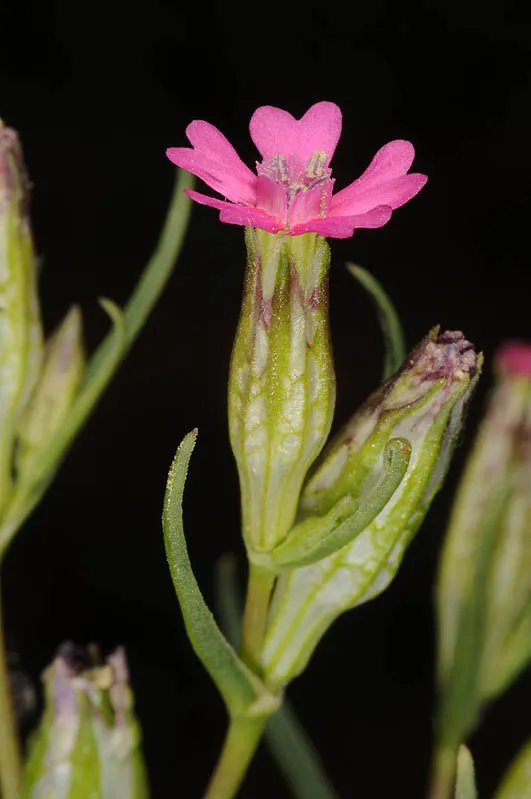Large-toothed Catchfly
Silene macrodonta





Silene macrodonta is currently
known only from a single site in the country, in southern Samaria. It was
considered extinct in Israel until 1986 when Ori Fragman found it on Mount Ba'al Hatsor. Dinsmore collected it in Jerusalem in the
Judean Mountains 90 years earlier but it has not been found there again. A
population was also discovered in 1988 at Har Gilo, although it was destroyed
with the development of the community. A similar plant was recently found on
the sands of Caesarea (Shir Vered), but its identification is not final.
Fallow fields, abandoned terraces and Sarcopoterium
spinosum scrubland. In Turkey and
Cyprus, S. macrodonta grows as a weed
on traditionally cultivated agricultural fields and on sandy areas, on stabilized
sand and other sandy soils.
Silene
macrodonta belongs to a special section in the genus Silene
(Sect. Conoimorpha) characterized by a calyx with 15, 20, 30 or 60
veins, unlike other kinds of Silene that have only ten veins on the calyx.
In Israel there are three species that belong this section: S. macrodonta
that has 60 calyx veins, S.
coniflora that has 20
calyx veins and S. conoidea
that has 30 calyx veins . The
three plants are annuals that grow in arid habitats in the transition zone and
even in the desert. S. coniflora
is found mainly in the high
transition zone and in the Negev Highlands and has small purple flowers and S.
conoidea grows mainly
in the transition zone and is characterized by large elongated calyces. This
species has two forms in Israel – a common form, with a small corolla and a form
with a large corolla that is limited to southern Mount Hebron and the northern
Negev. No transitions forms have been found between the two species in Israel.
·
The number of regions in which Silene macrodonta grows decreased
from two to one, and the plant is now extinct in the Judean Mountains. The
population discovered on Mount Ba'al
Hatsor in southern Samaria
is probably an existing one that had been missed previously. Due to its modest dimensions
S. macrodonta is difficult to locate and this
may be the reason it had not been found for many years.
·
The population on Mount Ba'al Hatsor grows in a single patch extending over about 2 hectares and numbers
about 1,000 plants.
·
The sites where S. macrodonta once grew and
from which it is now extinct were damaged by development. The same threat now
faces the Mount Ba'al Hatsor population due to earthworks and land reclamation.
Its small patch and population size pose a threat of local extinction for
demographic reasons and due to random factors.
·
Mount Ba'al Hatsor is not located in a nature reserve.
·
There is no information available on the
global threat status and conservation risks of S. macrodonta. It does not
appear in red species lists.
The small Silene macrodonta patch on Mount Ba'al Hatsor should be demarcated and the population growing there should be
protected. The high eastern Judea and Samaria ridges should be surveyed to look
for additional S.
macrodonta sites.
Seeds should be collected from the Mount Ba'al Hatsor population to create a backup
population in refuge gardens.
Silene macrodonta grows on the
high, dry areas of the Eastern Mediterranean and its edges. Grows in Mediterranean
Turkey and penetrates to central and eastern Anatolia, the island of Karpathos
(between Crete and Rhodes), in the Syrian Desert, in Cyprus, Jordan (Moab
according to Post) and Israel (Coode & Collen, 1967; Meikle, 1977-1984).
Silene macrodonta is a small annual plant of fallow fields, agricultural
terraces and shrublands in eastern Samaria and Judea. It is an extremely rare
plant and found now only in a tiny patch. It is extinct in several sites due to
developmental activities and that continue to threaten the only remaining
surviving population as well.
Current Occupancy Map
| 1000 squre meter pixel | 5000 squre meter pixel | 10000 squre meter pixel | |
|---|---|---|---|
| number of observations | 0 | 0 | 0 |
| in total pixels | 0 | 0 | 0 |
| Family | Caryophyllaceae |
| Classification | On the endangered species list |
| Ecosystem | Mediterranean |
| Chorotype | Eastern Mediterranean |
| Conservation Site | Mount Ba'al Hatsor |
| Rarity |
1
6
6
|
|---|---|
| Vulnerability |
0
3
4
|
| Attractiveness |
0
0
4
|
| Endemism |
0
0
4
|
| Red number |
1
5.3
10
|
| Peripherality | N |
| IUCN category | DD EW EX LC CR EN VU NT |
| Threat Definition according to the red book | Critically endangered |
 Based on:
Based on:






